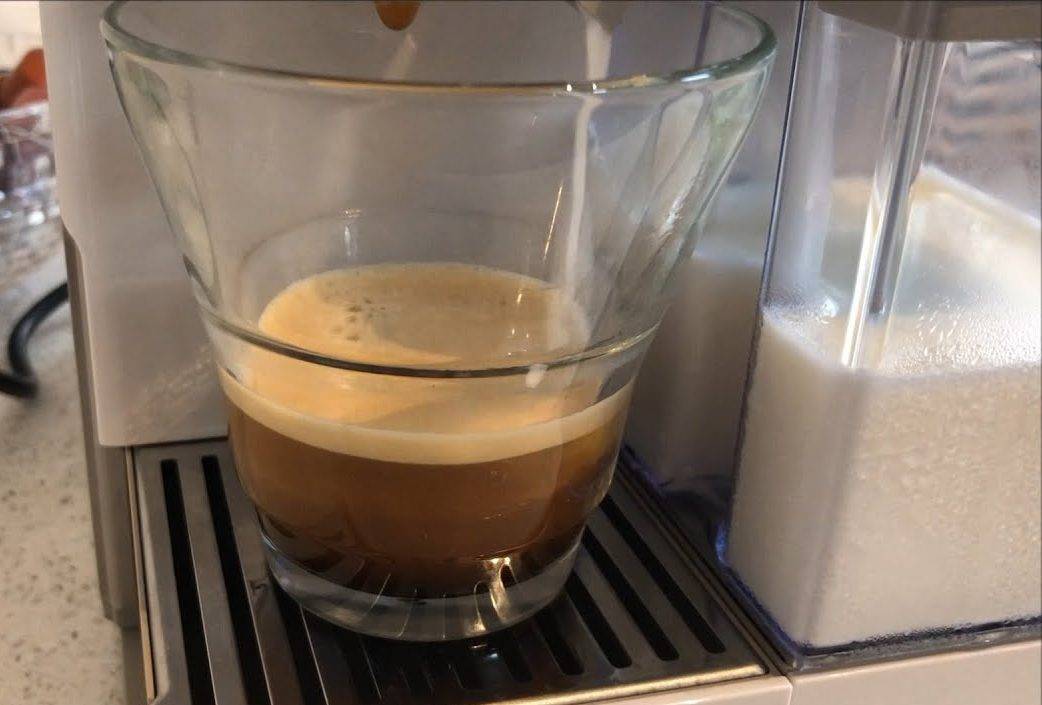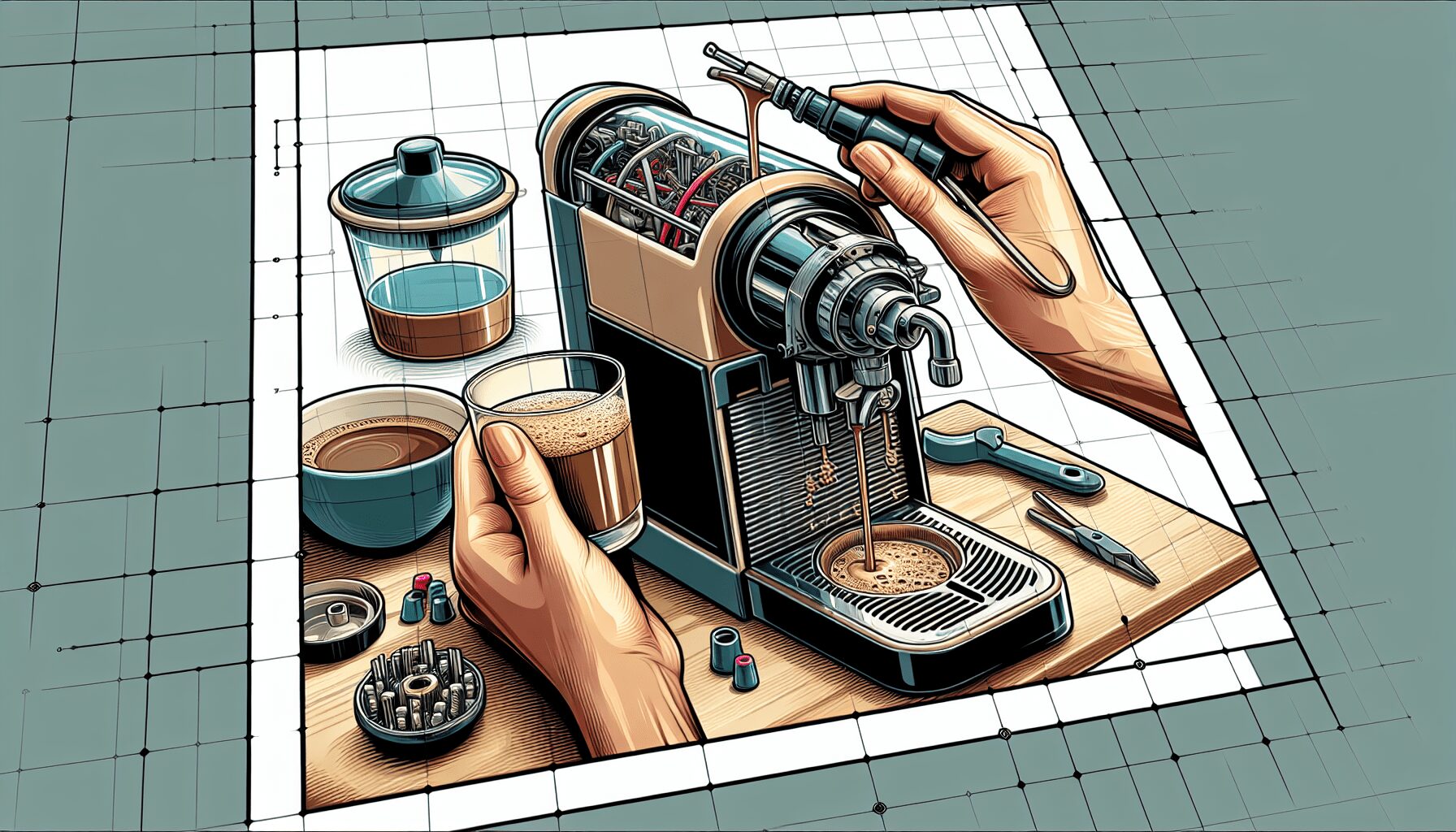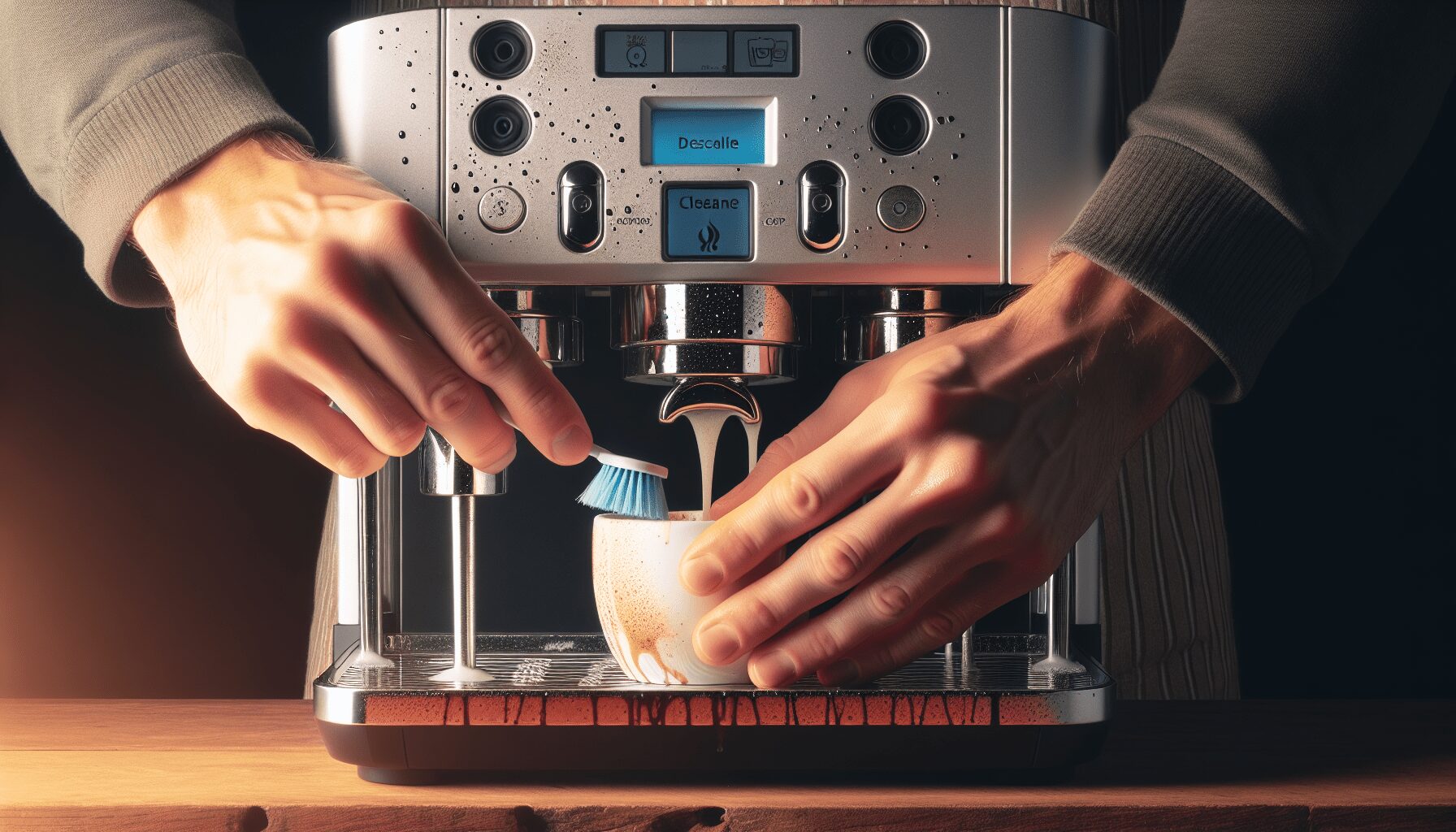If you’re a coffee lover who owns a Nespresso machine, then you know how crucial it is to keep your machine in top shape for that perfect cup of joe. But what exactly is descaling, and why is it so important? In this ultimate guide, we’ll take you through the step-by-step process of descaling your Nespresso machine, ensuring that your coffee always tastes amazing and your machine lasts for years to come. So grab your coffee mug and let’s dive into the world of descaling!
Why Descaling is Important
The importance of descaling your Nespresso machine
Descaling your Nespresso machine is an essential maintenance task that ensures the longevity and optimal performance of your beloved coffee maker. Over time, mineral deposits, also known as limescale or scale, can build up inside your machine’s internal components. These deposits can affect the taste of your coffee, clog the brewing system, and even lead to malfunctions. By regularly descaling your Nespresso machine, you can prevent these issues and enjoy a consistently delicious cup of coffee every time.
How scaling affects the performance of your machine
When limescale builds up inside your Nespresso machine, it can have various negative effects on its performance. Firstly, it can block the flow of water through the machine, resulting in slow or uneven coffee extraction. This can lead to weak or underwhelming cups of coffee. Additionally, the mineral deposits can affect the temperature consistency of the water, which in turn affects the flavor and quality of your coffee. Moreover, scaling can also cause the machine’s internal parts to deteriorate faster, leading to costly repairs or the need for a replacement machine.
Benefits of regular descaling
Regular descaling offers numerous benefits that go beyond just maintaining the performance of your Nespresso machine. Firstly, it ensures that your coffee always tastes its best by removing any lingering mineral residues that may alter the flavor. Descaling also helps prolong the lifespan of your machine by preventing limescale buildup that can contribute to mechanical issues. Furthermore, regular maintenance and descaling can save you money in the long run by reducing the need for repairs or premature replacements. By investing a little time and effort into descaling, you are ensuring the continued enjoyment of high-quality, delicious coffee.
When to Descaling Your Nespresso Machine
Signs that your Nespresso machine needs descaling
It is important to pay attention to the signs that indicate your Nespresso machine is in need of descaling. One of the most common indicators is a change in the taste of your coffee. If your coffee starts to taste off or bland, despite using the same coffee capsules, it is likely due to a buildup of limescale affecting the brewing process. Other signs include slower water flow, irregular or incomplete coffee extraction, and even visible residue or discoloration inside the machine. If you notice any of these signs, it’s time to take action and descale your Nespresso machine.
Frequency of descaling based on usage
The frequency of descaling your Nespresso machine depends on how often you use it and the hardness of your water. Generally, it is recommended to descale your machine every three months for moderate usage. However, if you use your Nespresso machine daily or have particularly hard water, you may need to descale more frequently. Hard water, which contains high levels of calcium and magnesium, promotes limescale buildup more rapidly. In such cases, descaling every one to two months may be necessary. Regular descaling will maintain the performance of your Nespresso machine and ensure that your coffee tastes as delicious as ever.
Preventive maintenance to avoid excessive scaling
While descaling is essential, taking preventative measures can help reduce excessive scaling and the need for frequent descaling. One effective preventive measure is using filtered or purified water in your Nespresso machine. By removing impurities and minerals from the water, you can significantly reduce the rate of limescale buildup. Another preventative maintenance step is cleaning and drying your machine properly after each use. This prevents moisture from lingering, which can contribute to the accumulation of limescale. Additionally, regular cleaning of removable parts and keeping the machine in a clean environment can help minimize scaling.
Preparing for Descaling
Gathering the necessary supplies
Before starting the descaling process, it is crucial to gather all the necessary supplies. You will need a descaling solution specifically designed for coffee machines, a clean container to hold the solution, and fresh water for rinsing. It is important to closely follow the manufacturer’s instructions regarding the type and quantity of descaling solution to use, as well as any specific guidelines for your Nespresso machine model. Ensuring that you have all the supplies ready beforehand will make the descaling process smoother and more efficient.
Understanding the descaling process
To descale your Nespresso machine, it is essential to have a clear understanding of the descaling process. Each Nespresso machine model may have slightly different procedures, so it is important to reference the user manual for specific instructions. However, in general, the descaling process involves running a descaling solution through the machine’s internal system to dissolve and remove limescale deposits. This is usually done using a descaling program or mode that is specific to the machine. Understanding the steps involved in the process will help you execute the descaling accurately and effectively.
Preparing your machine for descaling
Before starting the descaling process, there are a few steps to prepare your Nespresso machine. Firstly, ensure that the drip tray and capsule container are empty and clean. Remove any used capsules and rinse these parts thoroughly to remove any coffee residues. Next, ensure that the water tank of your machine is filled with fresh water. Additionally, make sure that your machine is turned on and plugged in, as the descaling program may require this. By properly preparing your machine, you are setting the stage for a successful descaling process.
Choosing a Descaling Solution
Types of descaling solutions available
When it comes to descaling your Nespresso machine, there are various types of descaling solutions available on the market. These solutions are specifically formulated to dissolve limescale and mineral deposits without damaging the internal components of your machine. Some descaling solutions come in liquid form, while others are in powder or tablet form. It is important to choose a descaling solution that is specifically recommended for Nespresso machines to ensure compatibility and effectiveness.
Considerations for selecting the right solution
When selecting a descaling solution for your Nespresso machine, there are a few factors to consider. Firstly, ensure that the solution is compatible with Nespresso machines, as using the wrong solution can damage your machine or void the warranty. Additionally, consider the quantity of solution required for descaling, as this can vary depending on the size of your machine and the severity of scaling. Reading customer reviews and recommendations can also provide insights into the effectiveness and ease of use of different descaling solutions. Ultimately, choose a solution that suits your specific needs and preferences.
Making your own natural descaling solution
If you prefer natural and chemical-free alternatives, you can make your own descaling solution using common household ingredients. One popular natural descaling solution for coffee machines is a mixture of equal parts white vinegar and water. Simply combine the vinegar and water in a clean container and follow the descaling process outlined in your Nespresso machine’s user manual. While natural solutions can be effective, it is important to note that they may not be as powerful as commercially available descaling solutions. Additionally, using vinegar may leave a lingering odor that could affect the taste of your coffee.
Descaling Your Nespresso Machine – Step by Step
Step 1: Emptying and cleaning the drip tray and capsule container
Before starting the descaling process, ensure that the drip tray and capsule container are empty and clean. Remove any used capsules and discard them. Rinse both the drip tray and capsule container with warm water to remove any remaining coffee residues. Once clean, dry them thoroughly before reassembling them back into the machine.
Step 2: Preparing the descaling solution
Following the manufacturer’s instructions for your chosen descaling solution, prepare the solution in a clean container. Measure the appropriate quantity of the descaling solution and mix it with the required amount of water. Ensure that the solution is mixed thoroughly, creating a uniform solution that is ready for use.
Step 3: Descaling the machine through the descaling program
Refer to your Nespresso machine’s user manual for the specific instructions on activating the descaling program or mode. Typically, this involves pressing a combination of buttons or following a specific sequence. Once the descaling program is initiated, the machine will begin pumping the descaling solution through its internal components. This process may take a few minutes, and it is important to follow the prompts on the machine’s display or refer to the user manual for any additional steps or instructions.
Step 4: Rinsing and cleaning the machine after descaling
After the descaling program is complete, it is crucial to thoroughly rinse and clean your Nespresso machine to remove any residual descaling solution. Fill the water tank with fresh water and run several cycles of water through the machine to thoroughly flush out any remaining descaling solution. It is recommended to repeat this rinsing process multiple times to ensure that no traces of descaling solution remain. Finally, as a precautionary measure, it is advisable to run a cycle of plain water through the machine to ensure that any residual taste or odor is eliminated.
Troubleshooting Descaling Issues
Common problems during descaling and how to solve them
While descaling your Nespresso machine is generally a straightforward process, there may be some common issues that could arise. One common problem is an error message or failure to activate the descaling program. In such cases, double-check that you are following the correct sequence of steps according to your machine’s manual. If the issue persists, contact Nespresso customer service for guidance. Another issue could be slow water flow during descaling. This may indicate a partially clogged system, and gently tapping on the machine or using a cleaning brush to dislodge any obstructions can help improve water flow. If you encounter any other problems, referring to the troubleshooting section of your machine’s manual or seeking assistance from Nespresso customer service is recommended.
Ensuring proper rinsing to eliminate residual descaling solution
One critical aspect of descaling is ensuring thorough rinsing after the descaling program. Failure to do so can result in lingering traces of descaling solution, which can affect the taste of your coffee and potentially be harmful if consumed. To ensure proper rinsing, run multiple cycles of fresh water through the machine, as mentioned in step 4 of the descaling process. It may also be helpful to taste a cup of water from the machine to check for any residual taste or odor. If there is any indication of a lingering descaling solution, continue rinsing until the water tastes clean and odor-free.
Dealing with stubborn scale deposits
In some cases, particularly with severe limescale buildup, there may be stubborn scale deposits that are difficult to remove through the regular descaling process. If you encounter such deposits, a more aggressive approach may be necessary. You can try soaking affected parts, such as the water tank or the brewing unit, in a solution of descaling solution and water for an extended period. Then, using a soft brush or cloth, gently scrub the scale deposits until they dissolve. If stubborn scale deposits persist, it may be beneficial to consult the manufacturer or seek professional assistance to ensure the safe and proper removal of the scale.
Maintaining Your Nespresso Machine After Descaling
Cleaning and maintaining the brewing unit
After descaling your Nespresso machine, it is essential to regularly clean and maintain the brewing unit to ensure its continued performance. Refer to the user manual for specific cleaning instructions, as the cleaning process may vary depending on your machine model. Generally, you can remove the brewing unit and rinse it under warm water to remove any coffee residues. It is important to let the brewing unit dry completely before reattaching it to the machine. Regular cleaning of the brewing unit will prevent the buildup of coffee oils and residues, ensuring that your coffee tastes fresh and flavorful.
Regular cleaning of removable parts
Apart from the brewing unit, there are other removable parts in your Nespresso machine that require regular cleaning. This includes the water tank, drip tray, and capsule container. It is recommended to clean these parts every few weeks or as needed, depending on your usage. Use warm water and a mild detergent to clean these parts, and thoroughly rinse them to remove any detergent residue. Make sure the parts are fully dried before reassembling them into the machine. Regular cleaning of these removable parts will prevent any buildup or contamination that could affect the performance and hygiene of your Nespresso machine.
Tips for extending the lifespan of your Nespresso machine
To extend the lifespan of your Nespresso machine and ensure its continued performance, there are a few additional tips to keep in mind. Firstly, use filtered or purified water to reduce the accumulation of mineral deposits. This is especially important if you live in an area with hard water. Secondly, avoid using abrasive cleaners or scouring pads when cleaning your machine, as these can damage the surfaces. Instead, opt for soft cloths or non-abrasive cleaning tools. Additionally, store your Nespresso machine in a clean and dry environment to prevent dust or moisture buildup. Regular maintenance, proper cleaning, and cautious handling will contribute to the longevity of your Nespresso machine.
Frequently Asked Questions about Descaling
Can I use vinegar to descale my Nespresso machine?
Yes, you can use vinegar as a natural descaling solution for your Nespresso machine. A mixture of equal parts white vinegar and water can effectively dissolve limescale deposits. However, it is important to note that vinegar has a strong odor that may linger and affect the taste of your coffee. Additionally, vinegar may not be as powerful as commercially available descaling solutions and may require more thorough rinsing to eliminate any residual taste or odor. If you prefer a natural solution, vinegar can be a viable option, but make sure to follow the descaling process carefully and rinse the machine thoroughly.
How long does the descaling process take?
The duration of the descaling process can vary depending on the specific Nespresso machine model and the severity of scaling. In general, the descaling program itself takes around 15 to 20 minutes to complete. However, it is important to consider additional time for emptying and cleaning the drip tray and capsule container, preparing the descaling solution, and performing the post-descale rinsing and cleaning. In total, the entire descaling process can take approximately 30 to 45 minutes. It is advisable to allocate sufficient time and ensure that you follow each step carefully for effective descaling.
What happens if I don’t descale my machine?
If you neglect to descale your Nespresso machine regularly, there can be several negative consequences. Firstly, the taste of your coffee may become dull or off, as limescale affects the brewing process and alters the flavor. Secondly, limescale buildup can lead to clogged or inefficient water flow, resulting in weak or under-extracted cups of coffee. Moreover, continued neglect of descaling can cause more serious mechanical issues, such as malfunctioning pumps or even damage to the heating elements. These problems can be expensive to repair or may require the purchase of a new machine altogether. Therefore, regular descaling is vital to maintain the performance and longevity of your Nespresso machine.
Professional Descaling Services
Benefits of professional descaling
While descaling your Nespresso machine yourself is a viable option, opting for a professional descaling service can offer several benefits. Professional services are equipped with specialized tools and knowledge to thoroughly descale your machine, ensuring that every nook and cranny is cleaned. They can effectively tackle severe limescale buildup that may be challenging to remove on your own. Additionally, professional descaling services can provide a convenient and time-saving solution, especially if you have a busy schedule or prefer to leave the task to experts. By choosing a professional descaling service, you can have peace of mind knowing that your Nespresso machine is in the hands of professionals.
When to consider professional descaling services
There may be instances where professional descaling services are a better option than descaling your Nespresso machine yourself. If you notice severe limescale buildup, persistent issues with taste or water flow, or if your machine is not performing optimally after descaling, it may be time to seek professional assistance. Professional descaling services have the expertise and experience to handle challenging descaling situations, ensuring that your machine’s performance is restored to its best. Additionally, if you lack the time, knowledge, or confidence to descale your machine yourself, professional services can offer a convenient and reliable solution.
Choosing a reputable descaling service provider
When choosing a professional descaling service provider for your Nespresso machine, it is essential to select a reputable and trustworthy company. Look for service providers that specialize in coffee machine maintenance and have experience working with Nespresso machines. Reading customer reviews and testimonials can provide insights into the quality of service offered. Additionally, consider factors such as the service charges, turnaround time, and any guarantees or warranties provided. By selecting a reputable provider, you can have confidence in the quality of service and enjoy the benefits of a professionally descaled Nespresso machine.
Conclusion
Regular descaling is a vital aspect of maintaining your Nespresso machine and ensuring its optimal performance. By removing limescale and mineral deposits, you can enjoy a consistently delicious cup of coffee with every brew. The descaling process, though requiring some time and effort, is relatively straightforward. By following the step-by-step instructions and utilizing the right descaling solution, you can effectively clean your machine and prevent potential issues. Remember to pay attention to signs that indicate the need for descaling and perform preventive maintenance to reduce excessive scaling. By taking care of your Nespresso machine through regular descaling and proper maintenance, you can enjoy the perfect cup of coffee every morning and extend the lifespan of your beloved coffee maker.



